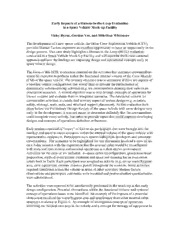
NASA Technical Reports Server (NTRS) 20080012530: Early Impacts of a Human-in-the-Loop Evaluation in a Space Vehicle Mock-up Facility PDF
Preview NASA Technical Reports Server (NTRS) 20080012530: Early Impacts of a Human-in-the-Loop Evaluation in a Space Vehicle Mock-up Facility
Early Impacts of a Human-in-the-Loop Evaluation in a Space Vehicle Mock-up Facility Vicky Byrne, Gordon Vos, and Mihriban Whitmore The development of a new space vehicle, the Orion Crew Exploration Vehicle (CEV), provides Human Factors engineers an excellent opportunity to have an impact early in the design process. This case study highlights a Human-in-the-Loop (HITL) evaluation conducted in a Space Vehicle Mock-Up Facility and will describe the human-centered approach and how the findings are impacting design and operational concepts early in space vehicle design. The focus of this HITL evaluation centered on the activities that astronaut crewmembers would be expected to perform within the functional internal volume of the Crew Module (CM) of the space vehicle. The primary objective was to determine if there are aspects of a baseline vehicle configuration that would limit or prevent the performance of dynamically volume-driving activities (e.g. six crewmembers donning their suits in an evacuation scenario). A second objective was to step through concepts of operations for known systems and evaluate them in integrated scenarios. The functional volume for crewmember activities is closely tied to every aspect of system design (e.g. avionics, safety, stowage, seats, suits, and structural support placement). As this evaluation took place before the Preliminary Design Review of the space vehicle with some designs very early in the development, it was not meant to determine definitely that the crewmembers could complete every activity, but rather to provide inputs that could improve developing designs and concepts of operations definition refinement. Each session consisted of “crews” of four to six participants that were brought into the mockup and asked to enact scenarios within the internal volume of the space vehicle with representative equipment. Participants were system/subsystem developers and astronaut crewmembers. The scenarios to be highlighted for this discussion involved a crew of six on a 3-day mission with the expectation that the internal cabin would be reconfigured with seats and suits stowed and nominal operations in a shirt-sleeve environment. Activities for the crew of six included: in-space cabin reconfiguration, group meal/meal preparation, medical event/patient treatment and space suit donning for an evacuation return back to Earth. Each participant was assigned an activity (e.g. set up waste/hygiene area, stow equipment, monitor avionics panel) throughout the scenario. Some activities required translation across the volume in areas of other activities. Human factors observations and participant comments were recorded and post-evaluation questionnaires were administered. The activities were reported to be satisfactorily performed in the mock-up in this early design configuration. Potential obstructions within the functional volume and systems’ concept of operations issues were identified. An example of the impacts of a potential obstruction involved the waste/hygiene area and interference from other internal cabin structures is shown in Figure 4. An example of incongruous concept of operations involving the medical care area in the vehicle and a concept for stowage of equipment in that same area was made apparent. Stowed items covered the area expected for medical treatment and in an emergency situation, removing items to perform patient care is undesirable. As participants in the evaluation and from out-briefs of findings, system developers are now updating space vehicle design concepts and concept of operations definitions. Photos to Include: Figure 1. Mock-up picture Figure 2. Starting configuration Figure 3a & 3b. Starting donning configuration and In-progress donning activity Figure 4. Waste/hygiene area obstruction Figure 5a & 5b. Starting cabin configuration of stowage area and ending medical care area
